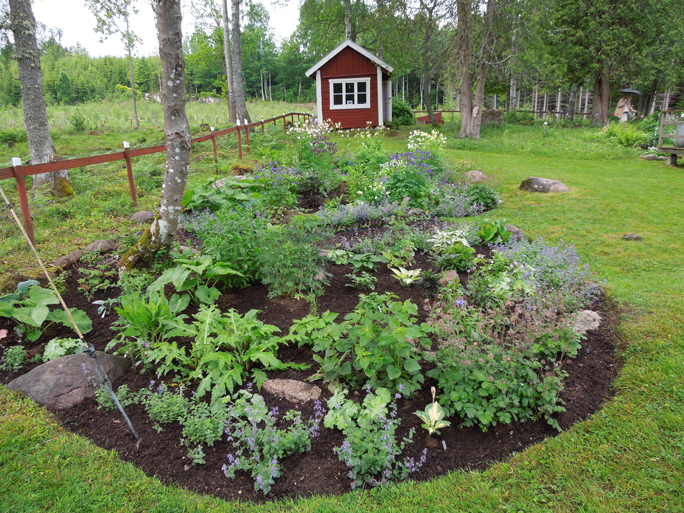Visited with the Lakeland Horticulture Society (LHS) June 7th, 2014
We left Vadstena early Saturday morning headed southeast to the seaside port city of Oskarshamn on the Baltic Sea. The intermittent rainfall that started shortly after we bordered our coach would follow our travel throughout the day. The vista of the open flat farmland of Vadstena disappeared. Rocky formations of moss covered boulders with ferns on the forests floor and a profusion of wild lupines filling the roadside ditches was our travel scenery. Passing glimpses of gardens in yards showed golden raintrees with their clusters of dripping yellow flowers, bright red poppies and blooming lilacs bushes.

Our Saturday morning stop was to visit LHS members Ray Lakeland (a council member of the Society) and his wife Margaret, from Kirby Lonsdale, a small town in the south Lakeland District of Cumbria, England. They had bought a fixer-upper cottage in the woods of Sweden in 2008, as their May-to-September summer home. A post office sign was on one of the outbuildings which Ray, a retired postman, explained was a reminder of what gave him and Margaret the financial means to have a summer home in Sweden.

Two years ago after completing the major “do-it-yourself job” to make the cottage habitable, they turned their attention to create a series of small gardens plots on their half an acre of land. At the time of our visit there were over 200 different plantings.

They started the garden, carved out of the edge of the forest, by removing scrub from the soil that was thin, free draining and rocky.

Surrounding trees dry the soil and leach out nutrients so they mulch with compost annually.

Taking advantage of the dryer climate of Sweden (as compared to Cumbria), they have planted a garden with emphasis on plants that do not do as well in the Lake District. As an example, Echinacea does well in his Sweden garden and the hosta have fewer snails and slugs. The huchera does not do as well according to Ray, but possibly because it is a rabbit’s treat rather than the weather. Any damage could not be seen with the forget-me-not clusters of bright blue flowers in companion planting with the huchera.

Familiar to the Lake District, primula, peony, aquilegia and potted pelargonium were in June bloom. Foxglove, monarda, phlox, agastache, globe thistle, cowslip are a few of the other plants familiar to Sweden and British gardens that would follow with blooms later in the summer.

With Ray being a member of the propagation team at Holehird, this Swedish garden (still in it's infancy) is sure to multiply and expand over the next few years.

Due to sporadic downpours of rain our refreshments of tea, coffee and dessert were served in the cottage rather than the outdoor tent Ray and Margaret had decorated with Union Jack bunting for our visit. Inside we were still able to enjoy a view of the garden from the picture windows.

The weather broke momentarily as we said our goodbyes to Ray and Margaret. We left their new garden and rehabbed cottage with the Swedish flag flying from the front porch to continue our travel southeast for a noon lunch stop in the small town of Kisa.
Photos by Deborah McMillin